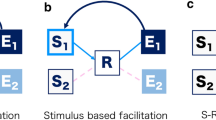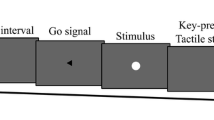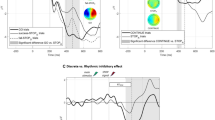Abstract
Human actions can be classified as being either more stimulus-based or more intention-based. According to the ideomotor framework of action control, intention-based actions primarily refer to anticipated action effects (in other words response-stimulus [R-S] bindings), whereas stimulus-based actions are commonly assumed to be more strongly determined by stimulus-response [S-R] bindings. We explored differences in the functional signatures of both modes of action control in a temporal bisection task. Participants either performed a choice response by pressing one out of two keys in response to a preceding stimulus (stimulus-based action), or pressed one out of two keys to produce the next stimulus (intention-based action). In line with the ideomotor framework, we found intention-based actions to be shifted in time towards their anticipated effects (the next stimulus), whereas stimulus-based actions were shifted towards their preceding stimulus. Event-related potentials (ERPs) in the EEG revealed marked differences in action preparation for the two tasks. The data as a whole provide converging evidence for functional differences in the selection of motor actions as a function of their triggering conditions, and support the notion of two different modes of action selection, one being exogenous or mainly stimulus-driven, the other being endogenous or mainly intention-driven.





Similar content being viewed by others
References
Allport DA (1987) Selection for action: Some behavioral and neurophysiological considerations of attention and action. In: Heuer H, Sanders AF (eds) Perspectives on perception and action. Lawrence Erlbaum, Hillsdale, NJ, pp 395–419
Allport DA (1989) Visual attention. In: Posner MI (ed) Foundations of cognitive science. MIT Press, Cambridge, MA, pp 631–682
Aschersleben G, Prinz W (1995). Synchronizing actions with events: The role of sensory information. Percept Psychophys 57:305–317
Boussaoud D (2001) Attention versus intention in the primate premotor cortex. Neuroimage 14:40–45
Brookhuis KA, Mulder G, Mulder LJM, Gloerich ABM (1983) The P3-complex as an index of information-processing—the effects of response probability. Biol Psychol 17:277–296
De Jong R, Wierda M, Mulder G, Mulder LJM (1988) Use of partial stimulus information in response processing. J Exp Psychol Human 14:682–692
Dirnberger G, Fickel U, Lindinger G, Lang W, Jahanshahi M (1998) The mode of movement selection: Movement-related cortical potentials prior to freely selected and repetitive movements. Exp Brain Res 120:263–272
Donchin E, Coles MGH (1988) Is the P300 component a manifestation of context updating? Behav Brain Sci 11:357–374
Drewing K, Aschersleben G (2003) Reduced timing variability during bimanual coupling: A role for sensory information. Q J Exp Psychol 56:329–350
Eimer M (1996) The N2pc component as an indicator of attentional selectivity. Electroen Clin Neuro 99:225–234
Eimer M (1998) The lateralized readiness potential as an on-line measure of the central response activation processes. Behav Res Meth Ins C 30:146–156
Elsner B, Aschersleben G (2003) Do I get what you get? Learning about effects of self-performed and observed actions in infants. Conscious Cogn 12:733–752
Elsner B, Hommel B (2001) Effect anticipation and action control. J Exp Psychol Human 27:229–240
Falkenstein M, Hohnsbein J, Hoormann J (1994) Effects of choice complexity on different subcomponents of the late positive complex of the event-related potential. Electroen Clin Neuro 92:148–160
Fogassi L, Gallese V, Buccino G, Craighero L, Fadiga L, Rizzolatti G (2001) Cortical mechanism for the visual guidance of hand grasping movements in the monkey: a reversible inactivation study. Brain 124:571–586
Frith CD (1992) The cognitive neuropsychology of schizophrenia. Lawrence Erlbaum, Hillsdale, NJ
Fuller R, Nathaniel-James D, Ron M, Jahanshahi M (1997) Movement-related potentials preceding self-initiated vs. externally-triggered movements in patients with schizophrenia. J Psychophysiol 11:281–282
Gallese V, Murata A, Kaseda M, Niki N, Sakata H (1994) Deficit of hand preshaping after muscimol injection in monkey parietal cortex. Neuroreport 5:1525–1529
Georgiou N, Iansek R, Bradshaw JL, Phillips JG, Mattingley JB, Bradshaw JA (1993) An evaluation of the role of internal cues in the pathogenesis of parkinsonian hypokinesia. Brain 11:1575–1587
Georgiou N, Bradshaw JL, Iansek R, Phillips JG, Mattingley JB, Bradshaw JA (1994) Reduction in external cues and movement sequencing in Parkinson’s disease. J Neurol Neurosur Ps 57:368–370
Goldberg G (1985) Supplementary motor area structure and function: review and hypotheses. Behav Brain Sci 8:567–616
Gratton G, Coles MGH, Donchin E (1983) A new method for off-line removal of ocular artifact. Electroen Clin Neuro 55:468–484
Gratton G, Coles MGH, Sirevaag EJ, Eriksen CW, Donchin E (1988) Pre- and poststimulus activation of response channels: a psychophysiological analysis. J Exp Psychol Human 14:331–344
Greenwald AG (1970) Sensory feedback mechanisms in performance control: With special reference to the ideo-motor mechanism. Psychol Rev 77:73–99
Haggard P, Aschersleben G, Gehrke J, Prinz W (2002) Action, binding and awareness. In: Prinz W, Hommel B (eds) Common mechanisms in perception and action: attention and performance, Vol XIX. Oxford University Press, Oxford, pp 266–285
Hauf P, Elsner B, Aschersleben G (2004) The role of action effects in infant’s action control. Psychol Res (in press)
Hommel B (2003) Acquisition and control of voluntary action. In: Maasen S, Prinz W, Roth G (eds) Voluntary action: brains, minds, and sociality. Oxford University Press, Oxford, pp 34–48
Hommel B, Müsseler J, Aschersleben G, Prinz W (2001) The theory of event coding (TEC). A framework for perception and action planning. Behav Brain Sci 24:849–937
Iacoboni M, Woods RP, Mazziotta JC (1996) Brain-behavior relationships: Evidence from practice effects in spatial stimulus-response compatibility. J Neurophysiol 76:321–331
Jahanshahi M, Frith CD (1998) Willed action and its impairments. Cogn Neuropsych 15:483–533
Jeannerod M, Arbib MA, Rizzolatti G, Sakata H (1995) Grasping objects: the cortical mechanisms of visuomotor transformation. Trends Neurosci 18:314–320
Keller P, Wascher E, Prinz W, Koch I, Waszak F, Rosenbaum DA (2004) Intention-based and stimulus-based actions: where there’s a will there’s action-effect anticipation. (in preparation)
Knoblich G, Flach R (2001) Predicting the effects of actions: interactions of perception and action. Psychol Sci 12:467–472
Koch I, Kunde W (2002) Verbal response-effect compatibility. Mem Cognition 30:1297–1303
Kok A (1997) Event-related potentials (ERP) reflections of mental resources: a review and synthesis. Biol Psychol 45:19–56
Koivisto M, Revonsuo A (2003) An ERP study of change detection, change blindness, and visual awareness. Psychophysiology 40:423–429
Kornhuber HH, Deecke L (1965) Hirnpotentialänderungen bei Willkürbewegungen und passiven Bewegungen des Menschen: Bereitschaftspotential und reafferente Potentiale. Pflug Arch Ges Phys 284:1–17
Kunde W (2001) Response-effect compatibility in manual choice reaction tasks. J Exp Psychol Human 27:387–394
Libet B (1985) Unconscious cerebral initiative and the role of unconscious will in voluntary action. Behav Brain Sci 8:529–566
Libet B, Gleason CA, Wright EW, Pearl DK (1983) Time of conscious intention to act in relation to onset of cerebral activity (readiness potential). The unconscious initiation of a freely voluntary act. Brain 106:623–642
Logan GD (1988) Toward an instance theory of automatization. Psychol Rev 95:492–527
Luppino G, Murata A, Govoni P, Matelli M (1999) Largely segregated parietofrontal connections linking rostral intraparietal cortex (areas AIP and VIP) and the ventral premotor cortex (areas F5 and F4). Exp Brain Res 128:181–187
Mechsner F, Kerzel D, Knoblich G, Prinz W (2001) Perceptual basis of bimanual coordination. Nature 414:69–73
Müsseler J, Wühr P (2002) Response-evoked interference in visual encoding. In: Prinz W, Hommel B (eds) Common mechanisms in perception and action: attention and performance, Vol XIX. Oxford University Press, Oxford, pp 520–537
Naylor H, Halliday R, Callaway E, Yano L, Watson P (1987) P3 as an index of visual information processing. In Johnson R Jr, Rohrbaugh JW, Parasuraman R (eds) Current trends in event-related potential research (EEG Suppl. 40). Elsevier, Amsterdam, pp 235–240
Osman A, Moore CM (1993) The locus of dual task interference: Psychological refractory effects on movement-related brain potentials. J Exp Psychol Human 19:1292–1312
Passingham RE (1985) Memory of monkeys (Macaca mulatta) with lesions in prefrontal cortex. Behav Neurosci 99:3-21
Praamstra P, Oostenveld R (2003). Attention and movement-related motor cortex activation: a high-density EEG study of spatial stimulus–response compatibility. Cognitive Brain Res 16:309–322
Praamstra P, Stegeman DF, Horstink MW, Brunia CH, Cools AR (1995) Movement-related potentials preceding voluntary movement are modulated by the mode of movement selection. Exp Brain Res 103:429–439
Praamstra P, Meyer AS, Cools AR, Horstink MWIM, Stegeman DF (1996) Movement preparation in Parkinson’s disease—Time course and distribution of movement-related potentials in a movement precueing task. Brain 119:1689–1704
Praamstra P, Schmitz F, Freund HJ, Schnitzler A (1999) Magneto-encephalographic correlates of the lateralized readiness potential. Cognitive Brain Res 8:77–85
Prinz W (1997) Perception and action planning. Eur J Cogn Psychol 9:129–154
Rizzolatti G, Camarda R, Fogassi L, Gentilucci M, Luppino G, Matelli M (1988) Functional organization of inferior area 6 in the macaque monkey. II. Area F5 and the control of distal movements. Exp Brain Res 71:491–507
Sakata H, Taira M, Murata A, Mine S (1995) Neural mechanisms of visual guidance of hand action in the parietal cortex of the monkey. Cereb Cortex 5:429–438
Shedden JM, Nordgaard CL (2001) ERP time course of perceptual and post-perceptual mechanisms of spatial selection. Cognitive Brain Res 11:59–75
Sherrington CS (1906) Integrative action of the nervous system. Yale University Press, New Haven, CT
Verleger R (1988) Event-related potentials and cognition: A critique of the context updating hypothesis and an alternative interpretation of P3. Behav Brain Sci 11:131–156
Verleger R, Jaskowski P, Wascher E (2003) Evidence for an integrative role of P3, bridging stimulus- and response-related processing. J Psychophysiol 17:183–183
Wascher E, Wauschkuhn B (1996) The interaction of stimulus- and response-related processes measured by event-related lateralizations of the EEG. Electroen Clin Neuro 99:149–162
Wascher E, Reinhard M, Wauschkuhn B, Verleger R (1999) Spatial S-R compatibility with centrally presented stimuli: An event-related asymmetry study on dimensional overlap. J Cognitive Neurosci 11:214–229
Zießler M, Nattkemper D (2002) Effect anticipation in action planning. In: Prinz W, Hommel, B (eds) Common mechanisms in perception and action: Attention and performance, Vol XIX. Oxford University Press, Oxford, pp 645–672
Author information
Authors and Affiliations
Corresponding author
Rights and permissions
About this article
Cite this article
Waszak, F., Wascher, E., Keller, P. et al. Intention-based and stimulus-based mechanisms in action selection. Exp Brain Res 162, 346–356 (2005). https://doi.org/10.1007/s00221-004-2183-8
Received:
Accepted:
Published:
Issue Date:
DOI: https://doi.org/10.1007/s00221-004-2183-8




